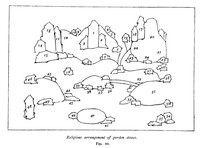From very ancient times it has been the custom, in the grounds of temples and monasteries, to apply a religious meaning to the principal stones, by giving them the names of different Buddhist deities, or the attributes of certain holy functions. Fig. 10 represents such an ideal arrangement of rocks and stones, which, even to the present day, serves in a modified form as a model for the distribution of the principal lithic ornament of gardens. The illustration includes forty-eight rocks, each bearing the names of some Buddha or saint, as follows:� 1, Mida Butsu. 2, Kwannon. 3, Seishi. 4, Kokuzo. 5, Mio-on-ten. 6, Shitsu-bosatsu. 7, Ka-bosatsu. 8, Bu-bosatsu. 9, Fugen-Monju-bosatsu. 10, Chikei-bosatsu. 11, Taishakuten. 12, Waku-Fudo. 13, Fugen-bosatsu. 14, Waku-Gundari. 15, Ki-bosatsu, Yashajin, and Go-bosatsu. 16, Kwaten. 17, Waku-Dai- itoku. 18, Bonden. 19, Kwaten. 20, Monju. 21, Futen. 22, Waku-kosanze. 23, Kwatsu-bosatsu. 24, Ri-bosatsu. 25, To-bosatsu. 26, Ho-bosatsu. 27, Satsu-bosatsu. 28, Ju-bosatsu. 29, Ga-bosatsu. 30, San-bosatsu. 31, Go-bosatsu. 32, Komokuden. 33, Rasetsuten. 34, Tamonden. 35, Sho-bosatsu. 36, Ho-bosatsu. 37, Ki-bosatsu. 38, Kwa-bosatsu. 39, Enten-mon. 40, Jiten. 41, To-bosatsu. 42, Shiten-bosatsu. 43, Sho-bosatsu. 44, Jishi-bosatsu. 45, Ko-bosatsu. 46, Saki-bosatsu. 47, Isha-bosatsu. 48, Jikokuden. Some of the above, though phonetically alike, are written with different ideographs.

